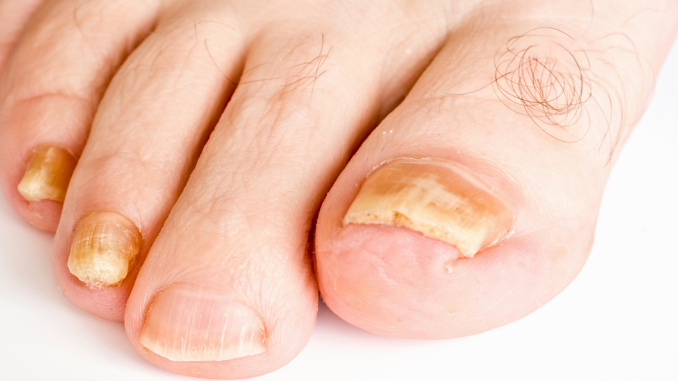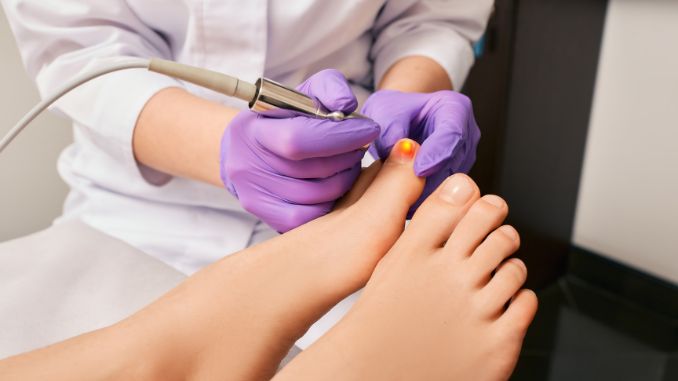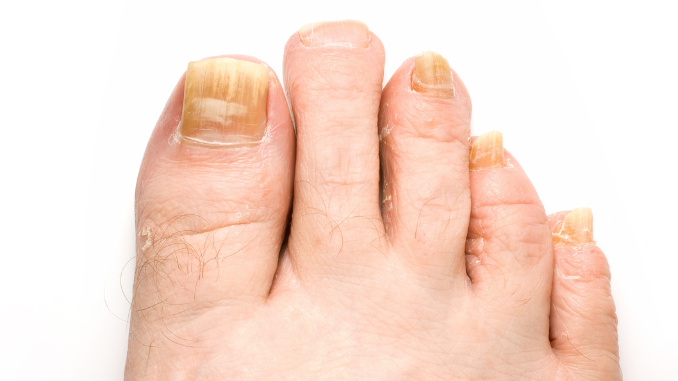Toenail fungus [¹], known as onychomycosis, is a common fungal infection affecting toenails, often with high recurrence rates. Onychomycosis is a nail infection caused by fungi, affecting up to 50% of people, especially adults 30-60 years old and older.
It’s prevalent among those over 60 and diabetics. There are seven types, with diagnosis often made by a solution that highlights fungal areas in dark or blue for clearer visibility.
Health Conditions That Affect Your Whole Body:
- Weak immune system
- Diabetes
- Poor blood flow in limbs
- Medicines that lower your immune system’s strength
Things Around You:
- Using shared showers or baths
- Wearing tight, non-breathable shoes
- Playing sports
- Often hurting your nails
Symptoms of Toenail Fungus

- Thickened nails
- Discoloration, such as yellowing or white patches
- Brittle or crumbly nails
- Distorted nail shape
- Darkening of the nail
- Build up of debris under the nail
- Foul odor emanating from the infected nail
- Separation of the nail from the nail bed
- Pain or discomfort in the affected toe
Treatment Options for Toenail Fungus

Treating toenail fungus [²] usually includes oral medicine, but topical treatments and procedures are also used to avoid side effects and recurrence.
A study found combining oral terbinafine with toenail cleaning had the fastest recovery. Recovery time can be longer for women, those with extreme body weight, or diabetes. Treatment success varies by gender, with women often seeing better results.
Disclaimer: Further research is needed to confirm these findings and explore additional treatment options.
Toenail Fungus treatment options include:
1. Oral Medications:

These medications are taken by mouth and are highly effective in managing toenail fungus.
Commonly used drugs include:
- Terbinafine and Itraconazole are the preferred treatments.
- Fluconazole is also common, especially for yeast-based fungus.
- Griseofulvin, an older medication, is less used because it requires long-term treatment and has a higher risk of the fungus returning.
2. Topical Treatments:
These are antifungal creams, gels, or lacquers applied directly to the nail.
Types include:
- Ciclopirox and Amorolfine lacquers are applied like nail polish and act by killing the fungal cells.
3. Mechanical Methods:

This involves physically removing the infected part of the nail.
Methods include:
- Nail filing or trimming to reduce the thickness of the nail.
- Surgical removal of part or all of the nail if the infection is severe.
4. Chemical Treatments:
- A special chemical is put on the nail to dissolve and remove the infected parts without needing surgery.
- This uses a paste specifically designed to target and eliminate the fungus.
5. Advanced Options:

- Combination Therapy: Using different treatments together, like oral pills and nail lacquer, to get better results.
- Boosted Therapy: Using a special material that makes the fungus weaker against the treatment, making the drugs work better.
6. Cutting-Edge Techniques:
New treatments are being tested, such as creating small holes in the nail to let medication soak in better, and using special light to stop fungus growth.
Suggestions for Prevention and Reducing Recurrence
Knowing how to know if toenail fungus is dying can help you determine if your treatment is working effectively and reduce the risk of recurrence. Toenail fungus, or onychomycosis [³], often comes back, with recurrence rates between 40% and 70%.
Recurrences are due to either the infection not being fully treated initially or a previously treated nail getting re-infected. Toenail growth is slow, taking up to 18 months to fully renew, which complicates treatment.
Factors like resistant fungi, nail thickness, slow growth, and health issues like diabetes or weak immune systems increase the risk of recurrence. Mistakes in diagnosis, not following treatment plans, and fungi resistant to treatments also make it hard to get rid of the fungus effectively.
Tips for Speeding up the Healing Process and Avoid Recurrence

Here are some tips to help speed up the healing process for toenail fungus:
- Ensure your feet stay clean and dry
- Trim nails regularly
- Avoid tight-fitting shoes
- Use antifungal powders or sprays
- Change socks frequently
- Avoid sharing personal items
- Consider dietary supplements
- Be patient in treating toenail fungus
- Apply Tea tree oil
How to Know if Toenail Fungus is Dying?

Recognizing how to know if toenail fungus is dying can help you gauge the effectiveness of your treatment and determine if you’re on the path to recovery.
Here are some signs that indicate the fungal infection [⁴] in your toenails is diminishing:
- Clearing at the Base: You might see a new, healthy nail growing from the nail base. It should look normal in color and texture, showing that the fungus is gone from that area.
- Improvement in Nail Color: A sign of improvement is when your nails start losing their yellow or brown color and begin returning to their natural shade.
- Reduced Thickness: As the fungus clears up, affected toenails will start to get thinner. This thinning shows that the extra keratin from the fungus is going away.
- Smoother Nail Surface: Fungal infections can make nails rough and crumbly. If the nail starts to get smoother and less brittle, it’s a sign the fungus is dying.
- Decreased Separation: If the nail has come loose from the nail bed (a condition called onycholysis), it should start to reattach as the infection clears up.
- Less Discomfort: As the fungal infection clears up, any pain, itching, or discomfort you were feeling will start to go away.
- No Advancement of the Infection: A clear sign that toenail fungus is going away is that it stops spreading to other nails or the skin around it.
Conclusion
Understanding how to know if toenail fungus is dying fungal nail infections is crucial for effective treatment, especially for those with diabetes. Spotting signs like color changes or thinner nails helps gauge progress. Stick to treatments, wear breathable shoes, and avoid sharing personal items to prevent recurrence. Seek medical advice and be patient with treatment to maintain foot health.
Unsure if your toenail fungus treatment is working? Learn how to spot the signs of dying fungus in our latest guide. Plus, don’t forget to check out our 14-Day Immune Health Quick Start Program to boost your overall health and wellness!

Frequently Asked Questions:
Does toenail fungus cause discomfort and affect nail appearance?
Toenail fungus can thicken, discolor, and crumble your nails, sometimes causing them to separate from the nail bed and hurt. Recognizing these signs is important for timely treatment.
What color does nail fungus turn when it dies?
When nail fungus is treated, the nail often starts to clear at the base, showing new, healthy growth. The nail color will slowly look more normal, losing any yellow or brown tint. This change indicates that the treatment is effective and the infection is cleared.
What happens if you have toenail fungus for too long?
Knowing how to identify if your toenail fungus is dying is crucial for effective treatment and prevention of further complications. Untreated toenail fungus can spread to other nails or skin, becoming harder to treat and potentially causing permanent nail damage. It can also lower your quality of life and self-esteem due to its appearance and discomfort.

Rick Kaselj MS, is a leading kinesiologist and injury specialist as well as co-creator of the best-selling Unlock Your Hip Flexors program. Rick creates exercise programs that help people heal injuries and eliminate pain, so they can go back to living a full, active, healthy life.



